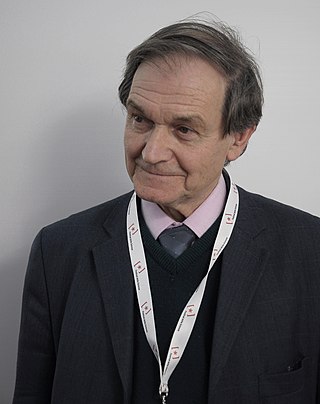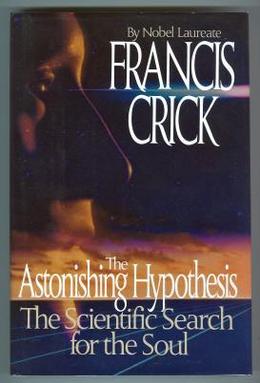
John von Neumann was a Hungarian-American mathematician, physicist, computer scientist, engineer and polymath. He was regarded as having perhaps the widest coverage of any mathematician of his time and was said to have been "the last representative of the great mathematicians who were equally at home in both pure and applied mathematics". He integrated pure and applied sciences.

Sir Roger Penrose is a British mathematician, mathematical physicist, philosopher of science and Nobel Laureate in Physics. He is Emeritus Rouse Ball Professor of Mathematics in the University of Oxford, an emeritus fellow of Wadham College, Oxford, and an honorary fellow of St John's College, Cambridge, and University College London.

Hermann Klaus Hugo Weyl, was a German mathematician, theoretical physicist, logician and philosopher. Although much of his working life was spent in Zürich, Switzerland, and then Princeton, New Jersey, he is associated with the University of Göttingen tradition of mathematics, represented by Carl Friedrich Gauss, David Hilbert and Hermann Minkowski.
The relationship between Buddhism and science is a subject of contemporary discussion and debate among Buddhists, scientists and scholars of Buddhism. Historically, Buddhism encompasses many types of beliefs, traditions and practices, so it is difficult to assert any single "Buddhism" in relation to science. Similarly, the issue of what "science" refers to remains a subject of debate, and there is no single view on this issue. Those who compare science with Buddhism may use "science" to refer to "a method of sober and rational investigation" or may refer to specific scientific theories, methods or technologies.

Deepak Chopra is an Indian-American author and alternative medicine advocate. A prominent figure in the New Age movement, his books and videos have made him one of the best-known and wealthiest figures in alternative medicine. His discussions of quantum healing have been characterised as technobabble – "incoherent babbling strewn with scientific terms" which drives those who actually understand physics "crazy" and as "redefining Wrong".

Brian David Josephson is a Welsh theoretical physicist and professor emeritus of physics at the University of Cambridge. Best known for his pioneering work on superconductivity and quantum tunnelling, he was awarded the Nobel Prize in Physics in 1973 for his prediction of the Josephson effect, made in 1962 when he was a 22-year-old PhD student at Cambridge University. Josephson is the first Welshman to have won a Nobel Prize in Physics. He shared the prize with physicists Leo Esaki and Ivar Giaever, who jointly received half the award for their own work on quantum tunnelling.

The Astonishing Hypothesis is a 1994 book by scientist Francis Crick about consciousness. Crick, one of the co-discoverers of the molecular structure of DNA, later became a theorist for neurobiology and the study of the brain. The Astonishing Hypothesis is mostly concerned with establishing a basis for scientific study of consciousness; however, Crick places the study of consciousness within a larger social context. Human consciousness according to Crick is central to human existence and so scientists find themselves approaching topics traditionally left to philosophy and religion.

Orchestrated objective reduction is a theory which postulates that consciousness originates at the quantum level inside neurons, rather than the conventional view that it is a product of connections between neurons. The mechanism is held to be a quantum process called objective reduction that is orchestrated by cellular structures called microtubules. It is proposed that the theory may answer the hard problem of consciousness and provide a mechanism for free will. The hypothesis was first put forward in the early 1990s by Nobel laureate for physics, Roger Penrose, and anaesthesiologist and psychologist Stuart Hameroff. The hypothesis combines approaches from molecular biology, neuroscience, pharmacology, philosophy, quantum information theory, and quantum gravity.
New mysterianism, or commonly just mysterianism, is a philosophical position proposing that the hard problem of consciousness cannot be resolved by humans. The unresolvable problem is how to explain the existence of qualia. In terms of the various schools of philosophy of mind, mysterianism is a form of nonreductive physicalism. Some "mysterians" state their case uncompromisingly ; others believe merely that consciousness is not within the grasp of present human understanding, but may be comprehensible to future advances of science and technology.
Dean Radin investigates phenomena in parapsychology. Following a bachelor and master's degree in electrical engineering and a PhD in educational psychology Radin worked at Bell Labs, as a researcher at Princeton University and the University of Edinburgh, and was a faculty member at University of Nevada, Las Vegas. He then became Chief Scientist at the Institute of Noetic Sciences (IONS) in Petaluma, California, USA, later becoming the president of the Parapsychological Association. He is also co-editor-in-chief of the journal Explore: The Journal of Science and Healing. Radin's ideas and work have been criticized by scientists and philosophers skeptical of paranormal claims. The review of Radin's first book, The Conscious Universe, that appeared in Nature charged that Radin ignored the known hoaxes in the field, made statistical errors and ignored plausible non-paranormal explanations for parapsychological data.

What the Bleep Do We Know!? is a 2004 American pseudo-scientific film that posits a spiritual connection between quantum physics and consciousness. The plot follows the fictional story of a photographer, using documentary-style interviews and computer-animated graphics, as she encounters emotional and existential obstacles in her life and begins to consider the idea that individual and group consciousness can influence the material world. Her experiences are offered by the filmmakers to illustrate the film's scientifically unsupported thesis about quantum physics and consciousness.
Robert George Jahn was an American plasma physicist, Professor of Aerospace Science, and Dean of Engineering at Princeton University. Jahn was also a founder of the Princeton Engineering Anomalies Research Lab (PEAR), a parapsychology research program which ran from 1979 to 2007.
Evan Harris Walker, was an American physicist and parapsychologist.
Quantum mysticism, sometimes referred pejoratively to as quantum quackery or quantum woo, is a set of metaphysical beliefs and associated practices that seek to relate consciousness, intelligence, spirituality, or mystical worldviews to the ideas of quantum mechanics and its interpretations. Quantum mysticism is criticized by non-believers with expert knowledge of quantum mechanics to be pseudoscience or quackery.

Shadows of the Mind: A Search for the Missing Science of Consciousness is a 1994 book by mathematical physicist Roger Penrose that serves as a followup to his 1989 book The Emperor's New Mind: Concerning Computers, Minds and The Laws of Physics.
The quantum mind or quantum consciousness is a group of hypotheses proposing that classical mechanics alone cannot explain consciousness, positing instead that quantum-mechanical phenomena, such as entanglement and superposition, may play an important part in the brain's function and could explain critical aspects of consciousness. These scientific hypotheses are as yet untested, and can overlap with quantum mysticism.

TM and Cult Mania is a non-fiction book that examines assertions made by the Transcendental Meditation movement (TM). The book is authored by Michael Persinger, Normand Carrey and Lynn Suess and published in 1980 by Christopher Publishing House. Persinger is a neurophysiologist and has worked out of Laurentian University. He trained as a psychologist and focused on the impacts of religious experience. Carrey is a medical doctor who specialized in psychiatry. He focused his studies into child psychiatry with research at Dalhousie University, and has taught physicians in a psychiatry residency program in the field of family therapy. Suess assisted Persinger in researching effects of geological phenomena on unidentified flying object sightings in Washington; the two conducted similar research in Toronto and Ottawa.
Quantum healing is a pseudoscientific mixture of ideas which purportedly draws from quantum mechanics, psychology, philosophy, and neurophysiology. Advocates of quantum healing assert that quantum phenomena govern health and wellbeing. There are different versions, which allude to various quantum ideas including wave particle duality and virtual particles, and more generally to "energy" and to vibrations. Quantum healing is a form of alternative medicine.
Rational mysticism, which encompasses both rationalism and mysticism, is a term used by scholars, researchers, and other intellectuals, some of whom engage in studies of how altered states of consciousness or transcendence such as trance, visions, and prayer occur. Lines of investigation include historical and philosophical inquiry as well as scientific inquiry within such fields as neurophysiology and psychology.
The Science of Consciousness is an international academic conference that has been held biannually since 1994. It is organized by the Center for Consciousness Studies of the University of Arizona. Alternate conferences are held in Arizona, and the others in locations worldwide. Each conference attracts hundreds of attendees. The conference is devoted exclusively to the investigation of consciousness.











